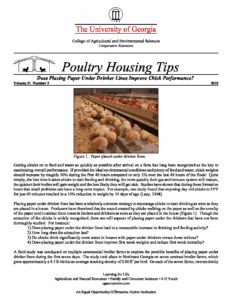Getting chicks on to feed and water as quickly as possible after arrival on a farm has long been recognized as the key to maximizing overall performance. If provided the ideal environmental conditions and plenty of feed and water, chick weights should increase by roughly 50% during the first 48 hours compared to only 2% over the last 48 hours of the flock! Quite simply, the less time it takes chicks to start feeding and drinking, the more quickly their gut and immune system will mature, the quic...ker their bodies will gain weight and the less likely they will get sick. Studies have shown that during these formative hours that small problems can have a long-term impact. For example, one study found that exposing day old chicks to 55oF for just 45 minutes resulted in a 10% reduction in weight by 35 days of age (Lacy, 1994).
Placing paper under drinker lines has been a relatively common strategy to encourage chicks to start drinking as soon as they are placed in a house. Producers have theorized that the sound created by chicks walking on the paper as well as the novelty of the paper tend to attract them towards feeders and drinkers as soon as they are placed in the house (Figure 1). Though the attraction of the chicks is widely recognized, there are still aspects of placing paper under the drinkers that have not been thoroughly studied. For instance:
1) Does placing paper under the drinker lines lead to a measurable increase in drinking and feeding activity?
2) How long does the attraction last?
3) Do chicks drink significantly more water in houses with paper under drinkers versus those without?
4) Does placing paper under the drinker lines improve first week weights and reduce first week mortality?
A field study was conducted on multiple commercial broiler farms to explore the possible benefits of placing paper under drinker lines during the first seven days. The study took place in Northeast Georgia on seven contract broiler farms, which grew approximately a 4.5 lb bird at an average stocking density of 0.80 ft2 per bird. On each of the seven farms, two randomly selected houses were used for the study. One house had no paper placed under drinker lines (Figure 2) and a second house had an 18” strip of paper placed under every drinker line (Figure 3). The paper used was brown, thin, and light, similar to that of a heavy tissue paper. The effect of paper under drinker lines was evaluated with water usage, chick body weights, first-week mortality, and time-lapse cameras. Water usage was monitored in each house with ultra-low-flow water meters, which continually measured and recorded water usage on a min-to-min basis. These meters provided the capability to monitor water usage the moment chicks start drinking at placement....
Details
| Year | Volume | Number | Categories |
|---|---|---|---|
| 2019 | 31 | 3 |

